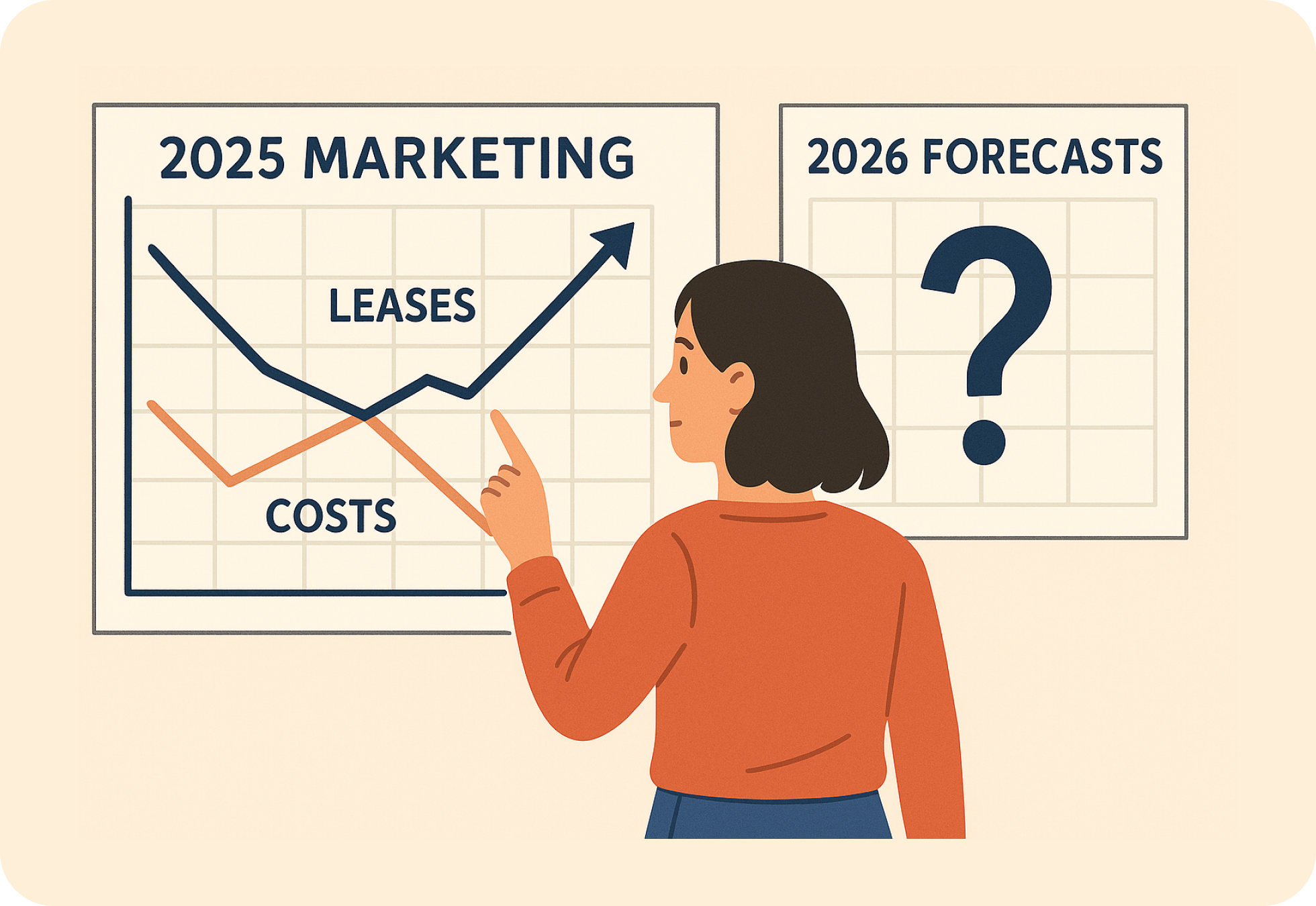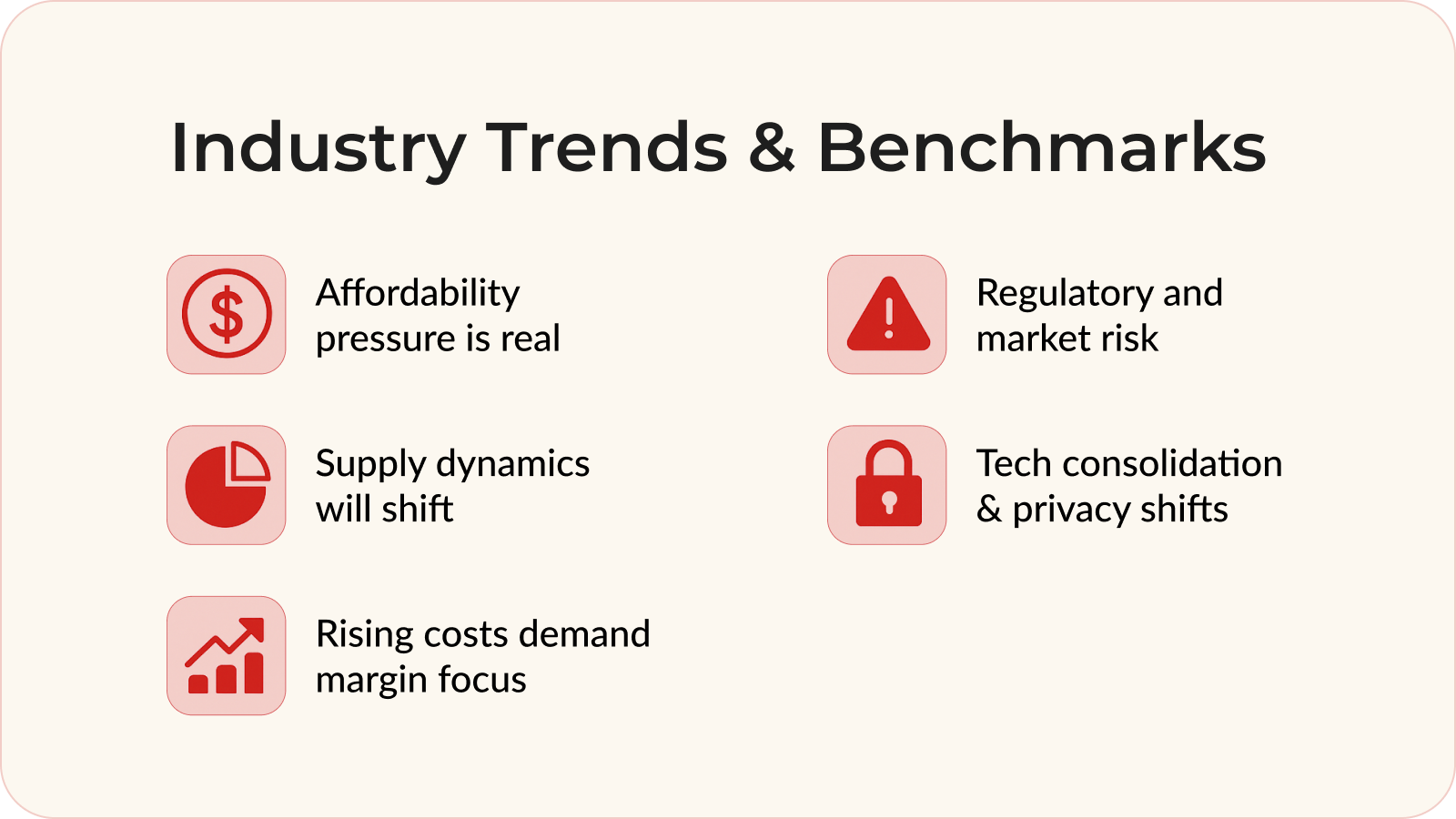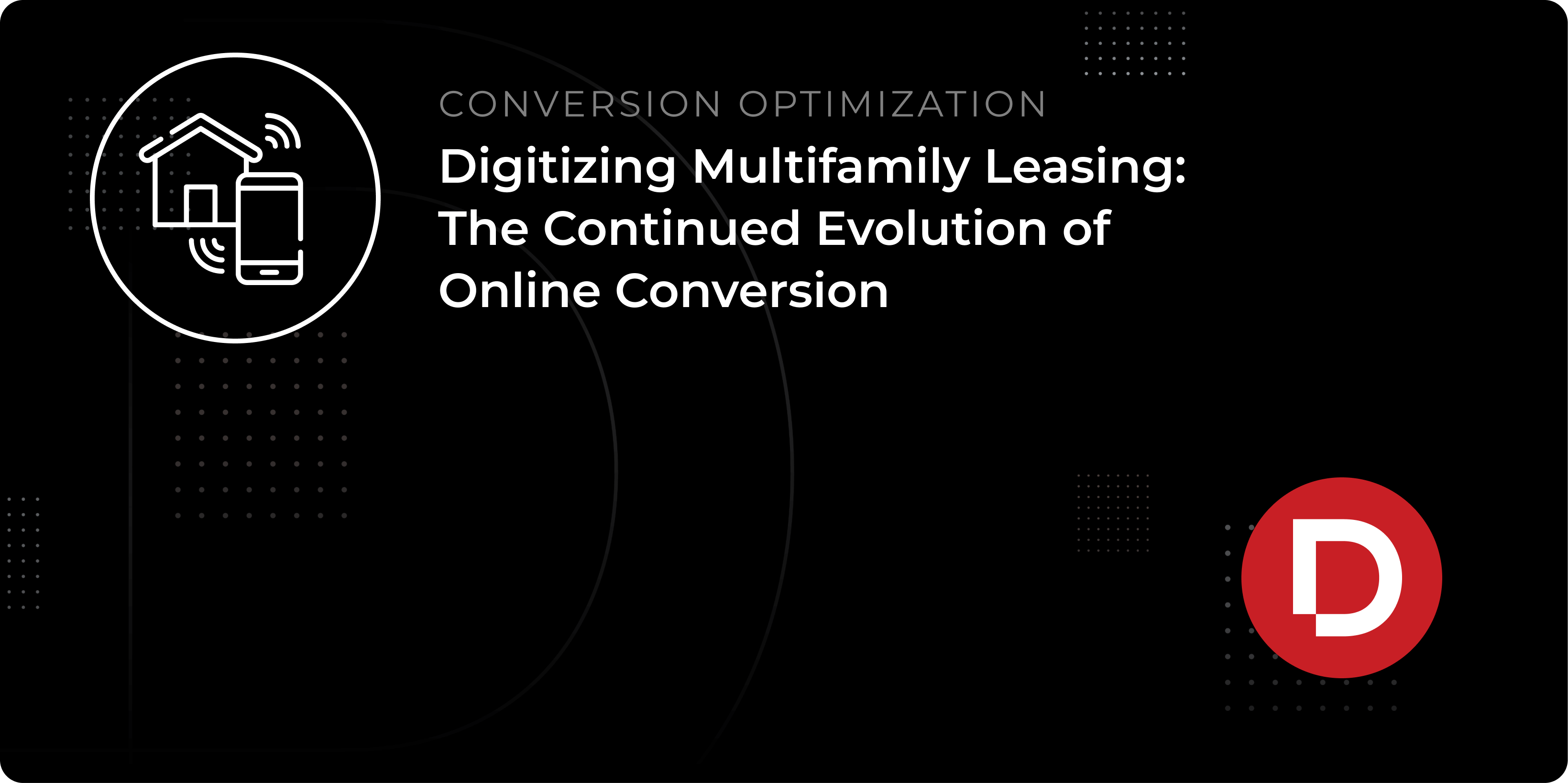Request Demo
Sign-up for a demo to see how our solutions can help you improve website conversion rate, generate more leases and simplify reporting.
We’re glad you’re here!
Thank you for choosing to continue to receive our communications. We look forward to continuing to engage with you. If there are any topics you’d like to make sure we cover, please feel free to reach out letsgo@dyverse.com.
Thanks for being awesome!


As 2025 draws to a close, multifamily operators and marketers alike are in that classic “pause and assess” moment. What campaigns delivered? Which channels underperformed? What external trends reshaped your strategy? In this post, we’ll walk through a structured reflection on this year’s performance, drawing insights from industry data and client-level learnings, and then sketch a forward-looking marketing playbook to position you for 2026.
Review the Core Metrics That Mattered
The first step in any strong year-end review is to return to the fundamentals: the key metrics that underpin marketing + leasing performance. Here are the ones we recommend tracking, and some high-level industry benchmarks to compare against:
Essential Metrics
- Occupancy/Lease-Up Rate: What percentage of your units are leased? How quickly did you fill new inventory or turnover units?
- Cost per Lead/Cost per Lease: How much did it cost to generate a lead, and ultimately a signed lease?
- Conversion Rate (Lead-to-Tour-to-Lease): At each funnel stage, where did drop-off occur?
- Average Days-on-Market (DOM): How long did units stay vacant before being leased? Renewal / Retention Rate: Of those eligible, how many current residents re-signed?
- Net Operating Income (NOI) Growth & Expense Trends: Marketing lives within a broader financial context - rising insurance, labor, and maintenance costs all eat into returns.
- Marketing ROI/Attribution Insights: Which channels delivered the most leases after accounting for their cost (not just leads)?
- Tenant Acquisition vs. Turnover Costs: The full cost of acquiring new residents vs. retaining ones.
In 2025, many properties felt pressure from elevated operating costs and soft rent growth, making margin optimization more critical than ever.
Industry Trends & Benchmarks
- Affordability pressure is real: As wage growth lags inflation and home ownership costs rise, renters are more cost-conscious. Marketing that emphasizes value, amenities, flexible lease terms, or bundled offers may resonate more.
- Supply dynamics will shift: The pipeline of new units is expected to slow, which gives existing properties a relative advantage.
- Rising costs demand margin focus: Keep a sharp eye on operational expense growth (insurance, maintenance, staff) and ensure your marketing contributes positively to NOI.
- Regulatory and market risk: Watch for increased scrutiny over algorithmic pricing, rent control dynamics, or changes in advertising-enabled regulation (e.g. anti-competitive scrutiny in rental ad syndication).
- Tech consolidation & privacy shifts: With evolving privacy rules, cookie less tracking, and data platform consolidation, marketers must ensure their tech stack is agile, privacy-compliant, and integrated.

When you compare your performance against those trends, you begin to see where your marketing strategy excelled, and where it trailed the market.
Spotlight Top-Performing Campaigns - And What Drove Their Success
Once you have your metrics baseline, the next step is to surface your best (and worst) campaigns. Here’s how to structure that review:
A. Identify Your High-Return Campaigns
Ask questions like:
- Which channels (search, social, programmatic, direct mail, referrals) generated the lowest cost per lease?
- Did certain creative motifs, messaging angles, or incentives outperform others?
- Which geographies or submarkets responded best?
- Did any seasonal or event-driven boosts (e.g. summer push, lease-up launch offers) materially shift the curve?
From what we saw across clients this year, some common patterns emerged:
- Campaigns with strong attribution models (e.g. first-touch, multi-touch, algorithmic attribution) allowed marketers to shift spend away from underperforming channels and double down on winners.
- Lead nurturing automations (e.g. drip sequences, chatbots) can push marginal leads through the funnel, trimming loss at each stage.
- Creative differentiation (targeted value props, floor plan personalization, amenity highlights) continues to drive performance, especially when combined with audience segmentation.
- Multi-touch and cross-channel consistency matter: prospects exposed across paid, display, social, email, and retargeting had higher conversion lifts.
- In tighter markets, lease concessions and incentives were still necessary, though many forecasts now expect them to dwindle later in 2025 as supply moderates.

B. Diagnose Underperformers and Missed Opportunities
No campaign is perfect. Consider these sources of drag:
- Weak attribution or siloed reporting that misallocates budget
- Overemphasis on “vanity” metrics (clicks, impressions) without rigor on lease outcomes
- Creative fatigue or reuse of stale messaging
- Timing mismatches (e.g. promotions running in lower demand months)
- Lack of funnel follow-up (leads “leaking” before conversion)
- Insufficient segmentation - “spray and pray” tactics that ignore localized nuance
At Dyverse, one of our service pillars is WALL attribution and cost-per-lease auditing. We routinely find that marketing teams underinvest in proper attribution, which obscures real performance differences across channels. Bringing that visibility back in often unlocks upside without increasing spend.
Lessons Learned & Strategic Adjustments for 2026
With a clear view of your metrics and campaign performance, the final step is to translate that into a smarter plan for 2026. Here are the key lessons, and how you can act on them.
A. Double Down on What Scales & Sustains
- Invest in attribution and media optimization: Ensure you can allocate spend dynamically among top-performing channels. Algorithms and neural-network–based attribution (e.g. next-gen MMM models) are now becoming more accessible and can better model long-term effects.
- Merge automation and human touch: Use AI or automation to streamline lead follow-up, qualify leads, and push funnel momentum; but retain human oversight and relationship-building where it matters.
- Segment, personalize, localize: Group your prospects by behavior, locale, income, amenity preferences - then tailor messaging so it lands more convincingly.
- Optimize seasonal timing and cadence: Use historical data to understand when demand surges and align campaigns accordingly (e.g. spring move-ins, holiday promotional windows).
- Test modest incentives where needed: With concessions expected to taper in 2025-2026, use them judiciously, only where the ROI justifies, especially in more competitive submarkets.
B. Plan for Headwinds & Structural Shifts
- Affordability pressure is real: As wage growth lags inflation and homeownership costs rise, renters are more cost-conscious. Marketing that emphasizes value, amenities, flexible lease terms, or bundled offers may resonate more.
- Supply dynamics will shift: The pipeline of new units is expected to slow, which gives existing properties a relative advantage.
- Rising costs demand margin focus: Keep a sharp eye on operational expense growth (insurance, maintenance, staff) and ensure your marketing contributes positively to NOI.
- Regulatory and market risk: Watch for increased scrutiny over algorithmic pricing, rent control dynamics, or changes in advertising-enabled regulation (e.g. anti-competitive scrutiny in rental ad syndication)
- Tech consolidation & privacy shifts: With evolving privacy rules, cookieless tracking, and data platform consolidation, marketers must ensure their tech stack is agile, privacy-compliant, and integrated.
Final Thoughts & Call to Action
A year-end review isn’t just about patting yourself on the back, or pointing out misses. It’s about giving your marketing roadmap clarity, injecting rigor into decisions, and sharpening focus for the year ahead.
At Dyverse, we believe that the difference between mediocre returns and standout performance lies in the quality of measurement, the agility of your media mix, and the intelligence in your marketing operations. Our tools, like WALL attribution and cost-per-lease auditing, are designed to pierce the fog and reveal real ROI levers.
If you’d like to walk through your 2025 campaign data, build a 2026 roadmap, or run a benchmark against peer properties, we are happy to help!
Here’s to making 2026 your most insight-driven, high-performing year yet.

Copy link
Share on LinkedIn
Share on X
Share on Facebook
More from Dyverse

- Automation/AI
- February 26, 2025
- 5 min read
Automation & AI in Multifamily Marketing: Transforming Lead Engagement and Conversion
The multifamily marketing landscape is undergoing a massive change, with automation and artificial intelligence (AI) playing a critical...
Let's start a conversation
Schedule a demo to discuss how Dyverse can help you boost your leasing performance.




